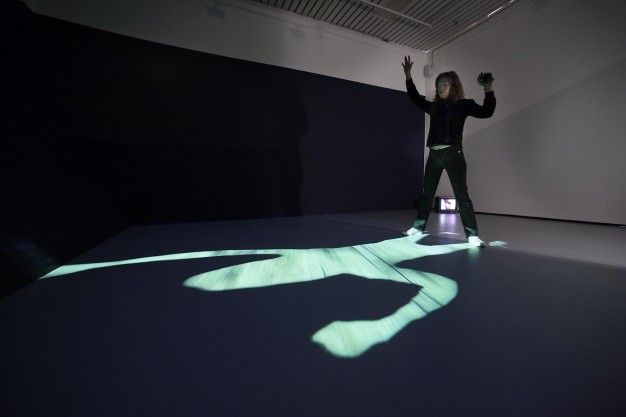HANNA HAASLAHTISuperpositions 8.8.2009 – 30.8.2009
 Trompe l'oeil, 2009
Trompe l'oeil, 2009computer assisted video installation
edition 3
Trompe l`oeil (2009) is an interactive installation that builds around video images projected onto shadowgraph images and shadows created by the viewers. A spatial performance between viewer and artwork gets underway when the shadows reveal an image on the floor. Our shadows act as an aperture that reveals another dimension to the space around us. The more people there are in the space the more details are revealed and the clearer the image becomes. Put another way, it is the presence of the viewers and the ensuing social situation that bring the piece into existence.
Thus, the intuitive physical expression of the human body is unleashed and the viewers´ collective actions take on random and unexpected forms. The piece becomes and event, a performance, whose dramatic tension and intensity are born out of the wholly unscripted action unfolding within the space. The piece seeks to examine the fleeting present as it passes, to explore our presence in the moment, the narrative arising in the here and now
The events of history belong to the past but sometimes the present cracks and splinters, revealing things we thought we had long ago forgotten. Are we responsible for events that took place before our time? Can we learn anything from them? The past is like a heavy train of fabric tailing behind us, exerting a mysterious influence over our life and being. These are some of the questions I have sought to address in Trompe l`oeil.
Trompe l´oeil, a trick of the eye, is an age-old painting technique used to create the illusion of another three-dimensional space within an interior. In my piece, this old practice is given a new lease of life with the help of digital technology.
The lenticular images of Paris Syndrome (2009) and the projected Real-Time Family (2008) and Cold Milk (2007) are concerned with contemporary mass phenomena such as tourism, television and the internet.
In a short space of time, the social media have fundamentally altered people´s understanding of the concepts of privacy and authorship, giving rise to a new non-spatial perspective, with the camera shutter as its vanishing point. It is as though this aperture gives us access to another world, where we are free to connect with other people. Our minds long for the digital world as we seek relief from the rationality, realism and disappointments shaping our present. The digital world offers up new fantastical coordinates, currently lacking in our real lives.
Here, the direct interaction between the viewer and the artwork gives way to an examination of a number of different interactive processes. The pieces follow photographers and viewers, both as subjects and objects, focusing on situations that lead us to reach for a camera.
Paris Syndrome links in with my Topography of miracles project, which I have used to explore the ways in which we make sense of the world through technology, through digital devices such as cameras and mobile phones. In public places their users revert to their own internal logic that is about much more than just capturing an image. They are engaged in a small-scale performance that reflects the impact exerted on us by the action determined by our digital tool.
In Paris, tourism takes the form of an assembly line. Faced with the famous attractions, people cling to their cameras as though grasping for a lifeline. No one sees anything, hears anything. Everyone is sunk in their own feverish determination to capture the moment as though the images might later reveal something valuable or be used to explain our reasons for visiting. The camera becomes a passage into another world. Tourism means averting your gaze, seeing the things that it is safe to see. In Paris, our eyes avoid the homeless asleep on the streets, the immigrants in the overcrowded suburbs, the harsh reality of the streets.
Every minute, thousands of photographs are loaded onto Flickr, the online photo sharing application. Real-Time Family picks out individual images from this real time stream and displays them in the gallery for a few moments. The piece reveals how, with the world clamouring for a presence of the internet, the meaning of individual images has become of secondary importance. We are creating an entirely new style of corpus, ever-growing visual networks that do not lend themselves to be easily understood. Real-Time Family is an attempt to make sense of this process as a dynamic event, a real time application that is constantly being updated. The stream of images displays a global, homogenous world, the human family.
Cold Milk observes viewers in front of a television. The musical score, with its promise of excitement of adventure, exerts a manipulative power over the emotions and physical being of a young child. The gleaming screen simultaneously repels and attracts, refusing to let go.
Hanna Haaslahti
